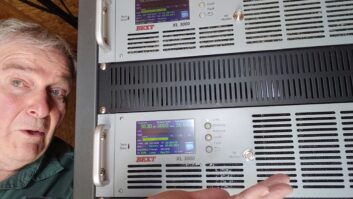Problem Solvers & Interfaces
Jul 1, 2001 12:00 PM, By Allan Soifer
My start in radio was as a part-time helper to a busy chief engineer. One of my first tasks was to demonstrate that I knew how to solder. I was handed a mic cable, and told to make an adaptor cable to connect a portable broadcast mixer to a consumer reel-to-reel tape deck.

I hesitated, and suggested that a well-known (to the burgeoning music and audio industry) brand of adapter plug be used to save time and money, and was reprimanded so severely that I never again brought up the subject of adaptors in this engineer’s presence. At the time, it was considered beneath a self-respecting engineer to fool around with anything that was not made expressly for the job or was not constructed entirely by the engineer himself for the need. Adaptor plugs were relegated to the junk and toy end of the audio realm.
Times have changed for the better. Now technicians often depend on specialized adaptors and interfacing devices to properly derive input signals, convey outputs from a console to auxiliary devices, and even to ensure the success of a remote or logging recorder. It’s possible to find any number of adaptors or custom interfaces in the electronic chain of the station.
Despite the ever-increasing collection of equipment designed expressly for the broadcast studio, it seems that programmers, producers, engineers, and even station owners will find a need for consumer-type devices and equipment. Indeed, some consumer or pro-sumer appliances function as well as their broadcast counterparts. For a small-budget station, specifying only the pro brands of equipment may wreak havoc with the bottom line. I have seen examples of not-for-profit FM outlets that could never have gotten on the air � nor stayed there � without interfacing consumer-level equipment into their air chain.
Interface needs
Let’s start by listing some usual situations and the devices that end up being inserted into the air-chain that do not come with a balanced-to-ground connection with a 0dBm level reference. There are CD players, cassette decks, open-reel tape decks, portable cassette decks, tuners, temporary phone connections for audio or data, PA systems for remote location use, connections to a client’s paging or background music system on a remote, computerized audio storage and playback devices, special effects or audio processing equipment, musical instruments for live-to-air performances, and more. What can be quickly seen is the need for both secure hum-free audio connections and a way to adapt differences in signal levels between the outboard goodies and the main console or patching facility.
Adapters and splitters should be a part of a complete interface kit.

It would be nice to plan a patch bay that includes such ready-to-use interfacing, but this is seldom the case due to budget constraints. Thus, the adaptor plug, or venerable black box, comes into play. A few manufacturers have had success in creating special adapting circuitry as retrofits for existing pro equipment.
What is presented here is hardly an exhaustive listing. As the phrase goes: your mileage may vary.
Why do it?
This question could easily be posed by many newcomers to the field. After all, professional equipment is supposed to be adaptable and have a wide range of input and output levels. While it’s true that most broadcast equipment is sturdy and forgiving of abuse, the audio signal that passes through it is rather fragile and easily wounded. Improper level matching can easily cause overloading of successive line amps and devices in the processing chain and might result in distortion on-air. Imbalances going the other way, as insufficient level, can elevate the noise floor of the audio chain and cause gating and pumping of background hiss.
Impedance mismatches can also cause level over- and under-loads, and more critically, high differentials of impedance interfere with the correct transfer of audio from one device to another � the primary result being a skewed frequency response. Often, a bad audio impedance match will rob almost all the bottom end, making the station sound like a two-way radio dispatcher.
Another consideration is safety. Proper grounding and safe electronic interfacing and interconnection of components will do much to remove the shock hazard sometimes posed within a broadcast facility. It does little good to install a new condenser mic if the announcer creeping up on it gets a nasty shock. Common sense, as well as power company regulations, require care in the mating of different pieces of equipment.
Devices to convert balanced and unbalanced signals, like these from Aphex, Henry Engineering and Sonifex, are necessary for proper level and impedance matching.

One final reason for using an interface device is to convert unbalanced to balanced status. Balanced lines are always preferable, due to their superior hum and noise rejection. Mic lines are typically 150V standard, and line level devices usually output 600V or less. The actual impedance may be any given figure depending on the audio passing through a device within a given moment; those numbers of 150 and 600 are reference points adopted many years ago.
Passive and active adaptors
Most passive adaptors are found in the hi-to-low level adjustment and impedance matching areas. Don’t let the word passive deceive you into thinking cheap or not useful. I have many times corrected hum-ridden audio feeds with a simple direct box. Inside a small steel container are a multi-tapped audio transformer, some connectors, a switchable resistive pad, and a ground lift switch. These components purchased separately would cost about $65.00 or so, plus the labor of building the device. The real cost savings is the construction time. Basic impedance flips are done with straight matching transformers. Shure, Switchcraft and Whirlwind have several transformers and mic accessories that ease the burden of level and impedance matching. Of course, the most basic passive adaptor is a piece of shielded cable, with different connectors on each end. Don’t overlook an assortment of these in various configurations.
We can’t get away without mentioning simple audio pads. For balanced signals, use an H-pad. A T-pad is used for unbalanced signals. Watch the quality of components when making them. One percent precision resistors are needed for the pad to function well and not lop off the audio response. Most textbooks on audio have resistor tables for pads, and I have often referred to the Audio Cyclopedia, and the Yamaha audio manual for this information. One critical factor is component packaging. Although it’s technically feasible to squeeze an H-pad into the shell of an XLR mic connector, don’t try it. Failure rates are fairly high on those contraptions. Build them inside of small steel boxes with chassis-mount connectors or an inline connector shell designed to house such projects.
Many manufacturers also offer premanufactured pads, phase reversal adapters and gender changers. The cost of the manufactured device will be higher than the components themselves, but the time saved easily justifies this.
An active box is one with various electronic circuitry within. The list of manufacturers is endless: ATI, Benchmark, RDL, Aphex, Ward-Back, Henry Engineering, Sonifex and SBS are but a few who make audio amps that have variable inputs and outputs for matching the typically lower (-10dBs) pro-sumer level to broadcast norms (+4dBm).
Remote broadcasts
Remotes are often one of the most challenging situations that a radio engineer faces. Under the watchful eye of the public, the boss and client must be satisfied and the announcer needs to be reassured. One device that caught my attention was a remote audio coupler and controller from Circuitwerkes. The DR-10 takes audio from any POTS line, or an auxiliary input, and interfaces into the console, while allowing the remote talent to control station automation from a touch-tone phone at the remote. Many manufacturers offer similar devices. It’s ideal for those smaller, tight-budget stations that would like to do weekend sports remotes, but come up short staffed. The remote announcer can break into the music programming, bring the remote audio up, and trigger spots and breaks from the site.
It is likely that you will find a small utility device to fit any need you may have.

Most remotes still use some form of line to connect to the studio, either POTS or ISDN. The mixer-couplers from JK Audio are interesting, offering telco line management, flexible headphone patching, and quiet mix channels. Check them out for cellphone and land-phone interfaces for quick audio interconnects, especially handy in the newsroom.
Telco tie-ins
Grabbing audio from a POTS line in a pinch is a basic task, but few engineers are equipped to properly terminate the line. Likewise, sending audio back up the line and nulling crosstalk is not a capability for most toolboxes.
For stations that extensively use telco services, it is wise to carry a hybrid. Gentner, Telos, Microtel and others make wide varieties of phone management equipment. Radio Systems has an inexpensive hybrid, and JK Audio has an extensive line of telephone interface and adaptive products.
Not just audio
Interfaces go beyond audio applications. One of the most inconvenient situations is the extended distance that may be needed between the CPU (tower) and the keyboard, mouse and monitor. Standard sets of extensions for PCs and Macs are available, usually at your local computer outlet. What may not always be at hand is a long extension for the monitor. I have run into several situations where I needed to extend the monitor 30 or 40 feet away from the CPU.
Telephone audio interfaces often provide a simple method of transmitting audio.

Despite what the guy behind the computer counter says, such extensions are made and used all the time. Talk to a local audio/visual presentation firm. They often use 50 or even 100-foot SVGA extensions to drive video projectors from a speaker’s lectern in conference rooms or hotel salons. The video is quite stable as long as the cable is low capacitance and well shielded. You may have to make one yourself or obtain it via mail or online catalogue since they are not a standard item.
No article on interfacing and adapting would be complete without paying homage to Switchcraft, ITT Cannon, Amphenol, and other connector manufacturers. Over the years, they have devised whole kits of various adaptor plugs and accessories to facilitate the plugging of almost anything into something else. While some of the offerings are unbalanced only, the incredible variety is very comforting to carry around in the engineers’ bag of tricks. A smart tech will carry several gender changers for mic and line level audio, computer connections, and a few Y adapters. One or two phase reversers are also a good idea, as is a pocket tone generator.
Allan Soifer is a recording and mixing engineer who works in Eastern Canada.












